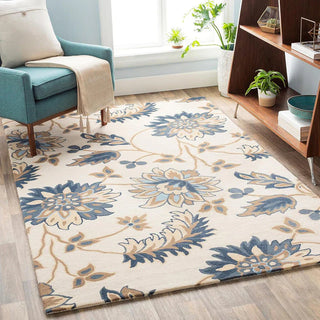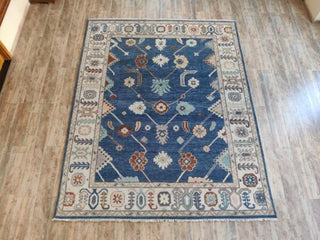Buying rugs online is incredibly convenient, offering you a wide variety of styles, materials, and sizes at your fingertips. However, one of the most common challenges is choosing the perfect size to fit your room. A rug that’s too small can make a space feel disconnected, while an overly large rug may overwhelm your décor. To help you get it just right, this comprehensive guide will walk you through measuring your space and selecting the ideal rug size for every room. Armed with this knowledge, you can confidently buy rugs online that enhance both the comfort and style of your home.
Why Rug Size Matters
Choosing the right rug size is essential because it impacts:
-
Room Proportion: A well-sized rug brings harmony to the space, balancing furniture and décor elements.
-
Functionality: The rug should provide enough coverage to make the space comfortable without restricting movement.
-
Aesthetics: The right rug anchors your furniture and creates visual flow, helping your design look intentional and polished.
Tools You’ll Need
Before you start measuring, gather the following:
-
Measuring tape or laser measure
-
Painter’s tape or masking tape to mark rug boundaries
-
Pen and paper or a smartphone app to note your dimensions
Step 1: Measure Your Room
Take accurate measurements of the length and width of your room. Don’t forget to consider architectural features such as doorways, windows, and radiators. Also, note the location and size of your furniture as this will influence rug placement.
Read More: How to Choose the Perfect Carpet for Every Room in Your Home
Step 2: Understand Common Rug Placement Types
There are several ways to position rugs within a room:
-
Under Furniture: The rug partially or fully sits under sofas, beds, or dining tables, helping define seating or sleeping areas.
-
In Front of Furniture: Smaller rugs placed in front of couches or beside beds to add warmth without dominating the floor.
-
Defining Zones: In open-plan spaces, rugs help visually divide areas such as a dining nook or workspace.
Step 3: Choose the Right Size for Your Space
Here are some general rug sizes and their best uses:
-
Small Rugs (2’x3’, 3’x5’): Great for entryways, kitchens, or as accent pieces.
-
Medium Rugs (5’x8’, 6’x9’): Perfect for under coffee tables or smaller living rooms.
-
Large Rugs (8’x10’, 9’x12’): Ideal for larger living rooms, dining rooms, and bedrooms.
-
Runners (2’x8’ or 2’x10’): Designed for hallways, kitchens, or narrow spaces.
Step 4: Visualize the Rug Size with Tape
Use painter’s tape to outline the rug’s dimensions directly on your floor. This simple step helps you see how much floor the rug will cover and how it interacts with your furniture and walking paths. It’s a practical way to avoid sizing mistakes before you buy rugs online.
Step 5: Consider Rug Shape and Layering
-
Rug Shape: Rectangular rugs are the most common, but round rugs can soften sharp corners and work well under circular tables or in small spaces.
-
Layering Rugs: For a trendy, textured look, layer a smaller rug over a larger neutral rug, especially in living rooms or bedrooms.
Step 6: Additional Tips When Buying Rugs Online
-
Check Product Dimensions Carefully: Sizes listed online may vary slightly; always confirm exact measurements.
-
Request Samples: Many retailers, including Carpet Planet, offer samples so you can see colors and textures up close before committing.
-
Read Reviews: Customer photos and feedback can provide real-life insights into rug size and appearance.
-
Know Return Policies: Good return policies make it easier to exchange rugs if the size isn’t perfect.
Conclusion
Knowing how to measure your space and select the right rug size is crucial when you buy rugs online. Proper sizing enhances your room’s balance, comfort, and style — helping you make the most of your new carpet. Carpet Planet offers a wide variety of rug sizes, styles, and expert guidance so you can find the perfect fit for your home.
Frequently Asked Questions (FAQs)
1. How do I measure my room to know what size rug to buy?
Use a measuring tape to record the length and width of your room. Then, decide where the rug will be placed (under furniture, defining zones, etc.) and measure that space accordingly. Using painter’s tape on the floor to outline potential rug sizes is a helpful visualization tool.
2. What size rug should I buy for my living room?
For most living rooms, an 8’x10’ rug works well, fitting under the front legs of sofas and chairs to anchor the seating area. Smaller living rooms may benefit from a 5’x8’ rug, while larger spaces might need rugs 9’x12’ or bigger.
3. Can I layer rugs to achieve a better look?
Yes! Layering rugs is a popular trend. Start with a larger neutral rug and layer a smaller, patterned or textured rug on top. This adds depth and style, and is great for defining different areas within open floor plans.
4. How much rug should be visible around my furniture?
Typically, you want 12 to 18 inches of floor visible around the edges of the rug, depending on the room size. For living rooms, placing at least the front legs of furniture on the rug helps tie the space together.
5. Is it better to buy a rug slightly bigger or smaller?
Buying a rug slightly bigger than smaller is usually better for balance and function. A larger rug can make a room feel more cohesive, while a too-small rug may appear disconnected from the furniture.



